Scleral Contact Lenses to the Rescue
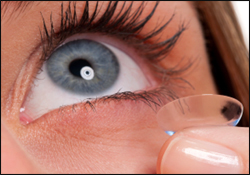 Today on Eye to the Future we will be discussing a type of contact lens you probably haven’t heard of before, but one that has helped many of our patients live fuller, happier, and more visually productive lives – Scleral Contact Lens.
Today on Eye to the Future we will be discussing a type of contact lens you probably haven’t heard of before, but one that has helped many of our patients live fuller, happier, and more visually productive lives – Scleral Contact Lens.
There are an estimated 38 Million contact lens wearers in the United States. For most of those, contact lenses are seen as a cosmetic privilege, allowing freedom from the need for glasses, to look better in pictures, or even to change their eye color!
For many though, hard contact lenses are a necessity to function and live a normal life.
Hard Contact Lenses are Still Around?!?
Most contact lenses wearers think hard contact lenses are a thing of the past. With the vast improvements in soft contact lens technology, that is partially true. However, there are many eye diseases and conditions that require hard lenses. Soft lenses or even glasses simply DO NOT provide adequate vision or comfort.
Scleral Contact Lenses
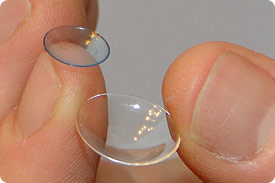 A newer type of hard lens for eye disease is the scleral contact lens.
A newer type of hard lens for eye disease is the scleral contact lens.
As the name implies, a scleral contact lens is a hard lenses that rest entirely on the white of the eye, called the sclera. They are much, much larger than traditional hard lenses (left).
These lenses vault over and do not even the touch the cornea, unlike all other contact lenses. A saline solution then fills in the area between the scleral contact lens and the cornea.
Scleral contact lenses are most useful for two eye problems:
Keratoconus and Corneal Ectasia
Severe Dry Eye and Sjögren’s syndrome
Corneal Ectasia (Bulging) and Keratoconus
 The cornea is the clear front surface of the eye. Normally, the cornea has a round regular shape, like a ball. Other times the cornea is more egg or football shaped. This is called an astigmatism and is also very normal.
The cornea is the clear front surface of the eye. Normally, the cornea has a round regular shape, like a ball. Other times the cornea is more egg or football shaped. This is called an astigmatism and is also very normal.
Sometimes, however, the structure of the cornea is not strong enough to hold a stable, rounded shape. The normal pressure inside the eye then causes the cornea to irregularly bulge outward in places like a cone.
This condition is called keratoconus (right) and is the most common cause of ectasia affecting 1 in 2000 Americans. About 50% of the time genetics is involved. In reality, it is most closely linked to eye rubbing, especially as a child.
In addition to keratoconus, corneal bulging (ectasia) can also occur after refractive surgeries like LASIK, PRK, and especially after RK or radial keratotomy, as well as after corneal transplants.
Why is Scleral Contact Lens Useful for Keratoconus/Ectasia
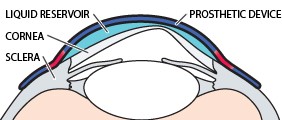 The cornea is the first surface that light goes through. The bulging irregular surface from ectasia heavily distorts the image going through it.
The cornea is the first surface that light goes through. The bulging irregular surface from ectasia heavily distorts the image going through it.
This causes substantial blurring and glare for a patient with ectasia.
Glasses cannot compensate for the irregular surface of the eye. Soft contact lenses do no better as they simply lay over top and conform to the bulging cornea.
Scleral contact lenses act as a PROSE or Prosthetic Replacement for the Ocular Surface Ecosystem (image above). A scleral contact lens vaults over the irregular cornea and fluid fills up the space in between, essentially creating a new, prosthetic cornea. Pretty cool, huh? And they work GREAT! Often scleral contact lenses will take an ectasia patient from not passing a drivers test down to the perfect 20/20 line and sometimes better!
Studies show that patients with ectasia who are switched to a scleral contact lens showed an 80% improvement in comfort and vision and a 90% improvement in overall satisfaction and quality of life.
Scleral Contact Lenses (Scleral Shell) for Severe Dry Eye and Sjögren’s Syndrome
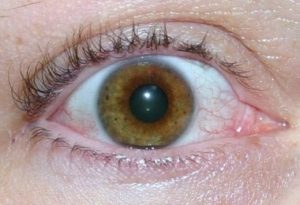 Dry eye syndrome is the most common cause of eye discomfort, affecting over 25 million Americans and 1 in 4 people over 60.
Dry eye syndrome is the most common cause of eye discomfort, affecting over 25 million Americans and 1 in 4 people over 60.
Mild to moderate dry eye is often successfully treated with artificial tears, prescription medications (like Restasis and steroids) or through simple in office procedures.
However, with severe dry eye, traditional options are often not adequate. In these cases, a scleral shell is used, especially for patients with Sjögren’s syndrome.
Sjögren’s Syndrome
Sjögren’s syndrome is an autoimmune disease where the body attacks the water secreting glands of the body. Most often affected are the salivary glands of the mouth and the lacrimal gland that produces the “water” part of the tears.
Because of the continual inflammation in these glands, Sjögren’s syndrome patients often have severe dry mouth and dental problems as well as incredibility dry eyes where traditional dry eye therapy is simply not effective enough.
Scleral Contact Lens (Scleral Shell) for Severe Dry Eye
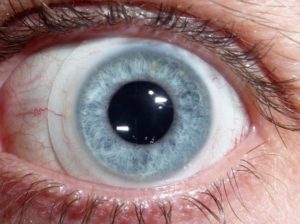 Patients with severe dry eye require copious amounts of lubrication to achieve comfort and provide sustained, acceptable vision.
Patients with severe dry eye require copious amounts of lubrication to achieve comfort and provide sustained, acceptable vision.
A scleral contact lens vaults over the sensitive cornea. The highly wettable surface of the lens provides clearer vision without the visual fluctuations often experienced with severe dry eye.
Most importantly, the lenses traps lubricating saline under the lens and against the sensitive cornea. This serves as a soothing water bath, with constant lubrication for the front surface of the eye.
If you or someone you know suffers from keratoconus, corneal ectasia, severe dry eye, or simply cannot obtain adequate vision with glasses or traditional contact lenses –
scleral contact lens may offer a solution.
For additional information or to schedule a fitting for scleral contact lenses, please contact us.
contact@precisionfamilyeyecare.com
As always, thank for tuning into Eye to the Future and I’ll see you on the next installment.
- Nick Wolf, OD
More information about Scleral Contact Lenses
Scleral Lens Education Society
All about Vision – Keratoconus
Our webpage on Scleral Lenses with additional links


